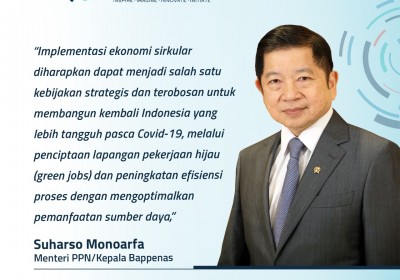‘Circular Economy’ Methods Aim to Push Economic Growth
March 16, 2021
Jakarta – The Indonesian government is currently promoting a “circular economy” concept to be used in their future development plans as they aim to become more carbon-efficient and environmentally sustainable.
Speaking on behalf of the government, the Minister of National Development Planning/Head of Bappenas Suharso Monoarfa explained that the implementation of a ‘circular economy’ can help the country’s economic growth and social reformation efforts.
“We hope that a ‘circular economy’ concept can aid us in strengthening our economy after the COVID-19 pandemic’s impact through the creation of more ‘green jobs’ for the workforce and placing more emphasis on efficient natural resource usage,” Minister Suharso said during the ‘A Circular Economy for a Greener Economy and Low-Carbon Development’ national webinar on Monday (25/1).
During the webinar, Minister Suharso presented the Economic, Social and Environmental Benefits of a Circular Economy in Indonesia report, which was compiled by Bappenas and UNDP Indonesia, with additional support from the Danish government.
The report showed that Indonesia would be able to add Rp 593 trillion to Rp 642 trillion to its gross domestic product (GDP) if circular economy practices were to be implemented onto 5 major industrial sectors. These sectors include the food and beverage (F&B) sector, textiles sector, the wholesale and retail sectors (with a focus on decreasing plastic packaging), the construction sector and the electronics sector.
Doing so would also help create an additional 4.4 million new jobs in these sectors by 2030.
A circular economy model would help an economy decrease its material consumption, waste production, and emissions rates while still achieving economic growth. Several countries have already implemented this model into their economies, such as Denmark.
“Sustainability is the key philosophy behind Denmark’s economy. We are delighted to share our knowledge regarding the implementation of circular economy practices and hope that Indonesia can adopt the same processes that can help them achieve sustainable development,” Denmark’s environmental Minister Lea Wermelin said.
Meanwhile, UNDP Indonesia head Norimasa Shimomura added that Indonesia would be able to gain significant economic, social and environmental benefits by implementing circular economy practices.
“Such a model would enable Indonesia to decrease its material consumption, waste production and emissions while also maintaining economic growth and the creation of more jobs. This model enables the country to tackle the challenges of climate change and improve the welfare of its population, especially vulnerable groups such as women, the elderly, children and the disabled, all of whom play an active role in their communities,” Norimasa explained.
Aside from stimulating economic growth, Bappenas projected that a circular economy model would also help Indonesia significantly reduce its greenhouse gas emissions.
“Based on our analysis, we observed that a circular economy model would accelerate Indonesia’s efforts to meet their greenhouse gas reduction target of 126 million tons by 2030 due to the fact that waste production would be decreased, more energy efficient practices would be applied and natural resources would be used more efficiently and sustainably by its industries,” Deputy for Maritime Affairs and Natural Resources Bappenas Arifin Rudiyanto said.
Indonesia’s Research Institutions Supporting the Development of the Electric Vehicle Industry
Indonesian Muslim Fashion and Cosmetics IKMs Shine at Dubai World Expo 2020
Govt Steps Up UMKM Transformation Efforts in the Midst of Pandemic Slowdown
Govt Encourages Promotion of IKM Products in Digital Era
Government Begins Developing Maritime Training Center in Makassar
Tweets by IDDevForum
